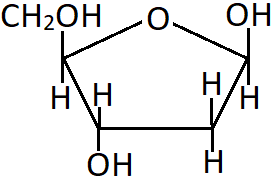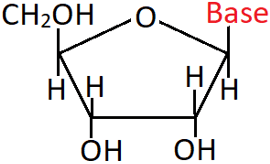This set of Class 12 Chemistry Chapter 14 Multiple Choice Questions & Answers (MCQs) focuses on “Biomolecules – Nucleic Acids”.
1. RNA on hydrolysis does not yield which of the following?
a) Amino acid
b) Pentose sugar
c) Nitrogen base
d) Phosphoric acid
View Answer
Explanation: RNA and DNA are nucleic acids which on complete hydrolysis yield a pentose sugar, phosphoric acid and nitrogen containing heterocyclic compounds called bases.
2. The following compound is a component of which of the following?

a) RNA
b) DNA
c) Adenine
d) Guanine
View Answer
Explanation: The compound shown is β-D-2-deoxyribose which is a pentose sugar. It has no oxygen (in the form of hydroxy) attached to the C2 carbon. It is the sugar moiety in deoxyribonucleic acid (DNA).
3. DNA is a polynucleotide.
a) True
b) False
View Answer
Explanation: Chromosomes are made up of proteins and nucleic acids. Nucleic acids are of mainly two types, DNA and RNA. Since they are long chain polymers of nucleotides, they are also called polynucleotides.
4. Which of the following bases is not present in DNA?
a) Adenine
b) Guanine
c) Thymine
d) Uracil
View Answer
Explanation: DNA contains four bases namely adenine (A), guanine (G), cytosine (C) and thymine (T). RNA also contains four bases, A, T, G and uracil (U).
5. Which of the following bases contain two keto groups?
a) Adenine
b) Guanine
c) Thymine
d) Cytosine
View Answer
Explanation: Bases are nitrogen containing heterocyclic compounds present in nucleic acids. Adenine has no keto group, guanine and cytosine have one keto group each, and thymine and uracil have two keto groups in their rings.
6. Which sugar is present in RNA?
a) β-D-ribose
b) β-D-fructose
c) β-D-galactose
d) β-D-2-deoxyribose
View Answer
Explanation: Nucleic acids are made up of units of pentose sugar, base and phosphoric acid that are linked together to form long chain. The sugar moiety in RNA is β-D-ribose.
7. The structure shown is that of a _______

a) DNA nucleoside
b) RNA nucleoside
c) DNA nucleotide
d) RNA nucleotide
View Answer
Explanation: A unit formed by the linking of a base to C1 carbon of a pentose sugar is called a nucleoside. The sugar shown is β-D-ribose and the base is uracil, hence it has to belong to RNA.
8. Nucleotides are linked together by bonds between 5’ and 2’ carbons of two different pentose sugars.
a) True
b) False
View Answer
Explanation: Nucleotides are joined together by phosphodiester linkage between the 5’ and 3’ carbon atoms of the pentose sugars.
9. Which of the following statements is correct?
a) Adenine is a pyrimidine
b) DNA is made of amino acids
c) Nucleosides do not contain phosphorous
d) RNA contains thymine
View Answer
Explanation: Adenine is a substituted purine as it has two fused rings. DNA is made up of nucleotides. RNA does not contain thymine, instead it has uracil. Nucleosides have a base attached to a pentose sugar. Since both the sugar and base do not contain phosphorous, nucleosides do not have it. On the other hand, nucleotides contain phosphorous in the form of phosphoric acid.
10. Which of the following best describes cytosine?
a) pyrimidine, present in RNA and DNA
b) pyrimidine, present only in DNA
c) purine, present only in RNA
d) purine, present in RNA and DNA
View Answer
Explanation: Bases (nitrogen containing heterocyclic compounds) are of two types. Those that have a single ring are purines, and those that have two fused rings are pyrimidines. Adenine, guanine and cytosine are present in both RNA and DNA.
11. The attachment between the base and sugar in a nucleotide is through ______ bond.
a) hydrogen
b) peptide
c) phosphodiester
d) glycosidic
View Answer
Explanation: In nucleotides, the sugar ring is attached to the base by a bond between C1 carbon of the sugar and the nitrogen atom of the heterocyclic ring. This is a N-glycosidic bond. The phosphate group is bonded to the hydroxyl group of the C5 carbon of sugar.
12. Which part of the nucleotide is responsible for the formation of bonds in DNA double helix?
a) Base
b) Sugar
c) Phosphate group
d) Hydroxyl group of sugar
View Answer
Explanation: In a DNA strand, the bases protrude outward whereas the sugar and phosphate lie in a straight chain. The bases pair up in specific pair through hydrogen bonds to form a double helix. Adenine forms two hydrogen bonds with thymine, whereas cytosine forms three hydrogen bonds with guanine.
13. Identify the complementary strand of the DNA primary structure ATGCCGATC.
a) AUGCCGAUC
b) TACGGCTAG
c) UACGGCUAG
d) GATCGGCAT
View Answer
Explanation: DNA does not contain uracil. Since adenine (A) pairs only with thymine (T) and cytosine (C) pairs with guanine (G), complementary strand will be TACGGCTAG.
14. Two DNA samples A and B have melting temperatures 305K and 320K respectively. Identify the correct statement based on this information.
a) A and B are complementary strands
b) B has more CG pairs than A
c) A has more CG pairs than B
d) A has more hydrogen bonds than B
View Answer
Explanation: CG bonds are made of triple hydrogen bonds and AT bonds are made of double hydrogen bonds. Since the melting temperature of B is higher than that of A, B should have more hydrogen bonds and as a result more CG pairs.
Sanfoundry Global Education & Learning Series – Chemistry – Class 12.
To practice all chapters and topics of class 12 Chemistry, here is complete set of 1000+ Multiple Choice Questions and Answers.
If you find a mistake in question / option / answer, kindly take a screenshot and email to [email protected]
- Practice Class 12 - Physics MCQs
- Practice Class 11 - Chemistry MCQs
- Practice Class 12 - Mathematics MCQs
- Check Class 12 - Chemistry Books
- Practice Class 12 - Biology MCQs
